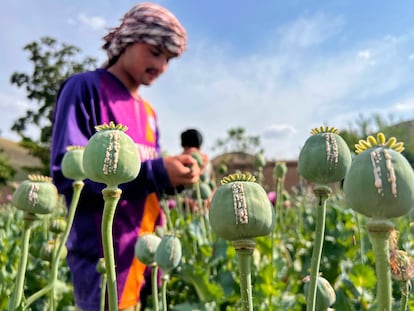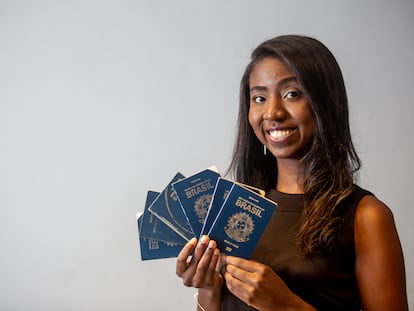Fatimah Hossaini, Afghan photographer: ‘I used to have problems with the fathers, brothers or husbands of the women I wanted to photograph’
The artist has focused her work on the beauty of the women of Afghanistan, working around wars and patriarchal restrictions. Since the Taliban returned to power, she has been living as a refugee in Paris. She tells EL PAÍS that the group has created a system of ‘gender apartheid that makes life impossible’


Fatimah Hossaini, 31, has been chased down the street by men who have insulted her and threatened her. They have sometimes managed to prevent her from doing her job: portraying the beauty of women in Afghanistan. “The only problem was that I was a woman with a camera on the streets of Kabul,” says this Afghan artist, who was born in Iran. However, despite the harassment, she remembers that stage in her life — the one which took place in the years before the Taliban returned to power in her country, in August of 2021 — as one of periods of the “greatest freedom” she ever experienced in her life.
To understand why Hossaini has focused her photographic project on capturing the beauty of Afghan women, work that she continues to do from her current exile in Paris, it’s necessary to turn to the “identity crisis” that she has experienced for a good part of her life. She has been the victim of triple discrimination: as an Afghan in Iran, as a woman in countries with strong patriarchal domination and as a member of the Hazara minority (a group of Shia Muslims in Afghanistan).
“Migration, identity and gender are the three most important themes of my work,” she says during an interview with EL PAÍS in Barcelona, within the framework of the Human Rights Defender project, organized in several Catalan municipalities at the end of last year.
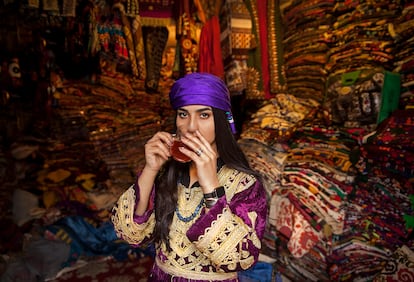
The granddaughter of Afghans who fled the country in the 1980s during the Soviet invasion, the artist led “a very Iranianized life.”
“I was completely integrated into Iranian society, because I was born there. But you can only be Iranian if your parents are, so three generations after my family’s migration, I was still Afghan.” And while she claims that she owes “her artistic career” to her Iranian teachers and the “influence of Persian culture,” she suffered “discrimination from school to university.”

“My life would have been easier if I had had Iranian nationality. [Since that] identity crisis was a part of my life, I tried to discover Afghanistan, especially the women,” she notes. The first Afghan women she met were her mother and her sisters. However, when she tried to find out what the others were like, she only found “the cliché of Afghan women portrayed in the media as victims, forced to cover themselves with a burqa.”
The search for the Afghan feminine essence was one of the reasons why she returned to Afghanistan in 2018, where she worked as a professor of photography at the University of Kabul. “I found many interesting, different and very valuable stories from Afghan women that made me reflect on why we’re always presented as a symbol of the victims of the world,” she reflects.
Hossaini is mindful that the restrictions imposed by “the patriarchal society” of Afghanistan — even before the return of the Taliban — were numerous. “I used to have problems with the parents, brothers or husbands of the women I wanted to photograph. And that’s why I used to turn to artists, musicians and actresses, who were familiar with the camera and let me publish their photos.” And, above all, they allowed her to show “the beauty hidden in the midst of war and misery… that femininity and that halo of hope.”

“In Iran, the government controls everything and forces you to [wear a hijab] if you’re a woman. But in Kabul, at that time, there were no police officers to tell you what to do or what not to do,” Hossaini recalls. “I wore the hijab on the street for my own safety, but not in classes, where I also had more female students than male students,” she explains.
Hossaini remembers the time before the return of the Taliban regime with some nostalgia. “There was a new lifestyle in Kabul, thanks in part to the fact that the new generations, especially those of us who came from the diaspora, returned to the country and tried to build something and bring a little freedom and many new ideas.”
Therefore, despite being a woman and a Hazara in a sexist society — a traditional target of the Taliban — she emphasizes that “it was fantastic” to be in her country of origin and to feel “so free.”
“We had women in all sectors: women doctors, women professors and women business owners and leaders of important institutions.”
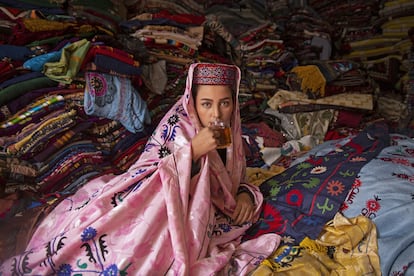
Last days in Kabul
However, the Taliban’s return to power threw women “into a gender apartheid that makes their lives impossible.” Even today, it’s difficult for her to believe the “horrors” that took place. On August 14, 2021, just one day before the fall of Kabul, in an interview with CNN, she denied the possibility of the Taliban regaining power: “I said very confidently that the new generation of Afghans would never allow a terrorist group [to take over Afghanistan again] and that the international community was also there to protect us.” Reality hit her the next morning, when, from her balcony, she saw “Taliban fighters in the streets, with their flags and their motorcycles.”
“I stayed at home for two days without eating, shocked and exhausted, until some friends came and we went to the airport together,” she says. She was able to escape three days later, because — in the middle of the chaos in the commercial terminal — the French ambassador recognized her. He had attended her photo exhibitions in Kabul. “[He helped get me out] and I flew to Paris,” she continues. “For me it was incredible that this happened before the eyes of the international community… I saw how everyone left, how my friends fled to other countries, how Afghanistan lost all its human talent, how no one resisted after four decades of wars and conflicts, how all our dreams and hopes were destroyed.”
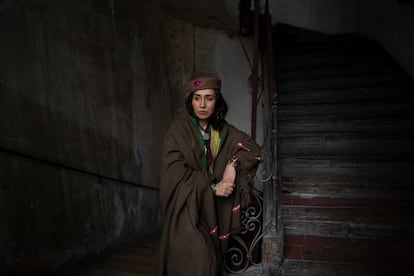
Paris made her relive the feeling she had experienced in Iran, of feeling like a foreigner. “It’s a beautiful and inspiring city to be an artist, but it’s not my home,” she sighs. However, she hasn’t given up her efforts to portray Afghan women: she looked for those who had taken refuge in France and found, once again, her hidden beauties. “I even photographed them with Afghan clothes and accessories, but on this occasion, as expatriates.” That beauty, she explains, also emerges amid adversity, because “living in exile requires courage and resilience… it forces you to live disconnected from your origins and integrate into a new language, living with a new people and a new culture, while, at the same time, you deal with the traumas that you carry.”
English version by Avik Jain Chatlani
Sign up for our weekly newsletter to get more English-language news coverage from EL PAÍS USA Edition
Tu suscripción se está usando en otro dispositivo
¿Quieres añadir otro usuario a tu suscripción?
Si continúas leyendo en este dispositivo, no se podrá leer en el otro.
FlechaTu suscripción se está usando en otro dispositivo y solo puedes acceder a EL PAÍS desde un dispositivo a la vez.
Si quieres compartir tu cuenta, cambia tu suscripción a la modalidad Premium, así podrás añadir otro usuario. Cada uno accederá con su propia cuenta de email, lo que os permitirá personalizar vuestra experiencia en EL PAÍS.
¿Tienes una suscripción de empresa? Accede aquí para contratar más cuentas.
En el caso de no saber quién está usando tu cuenta, te recomendamos cambiar tu contraseña aquí.
Si decides continuar compartiendo tu cuenta, este mensaje se mostrará en tu dispositivo y en el de la otra persona que está usando tu cuenta de forma indefinida, afectando a tu experiencia de lectura. Puedes consultar aquí los términos y condiciones de la suscripción digital.
More information
Archived In
Últimas noticias
Most viewed
- Sinaloa Cartel war is taking its toll on Los Chapitos
- Reinhard Genzel, Nobel laureate in physics: ‘One-minute videos will never give you the truth’
- Oona Chaplin: ‘I told James Cameron that I was living in a treehouse and starting a permaculture project with a friend’
- Why the price of coffee has skyrocketed: from Brazilian plantations to specialty coffee houses
- David King, chemist: ‘There are scientists studying how to cool the planet; nobody should stop these experiments from happening’
